Did you know that the Philippines engaged in trade with China as early as 982 AD? This early interaction highlights the rich history of pre-colonial diplomacy in the region. Long before modern international relations, the Philippines was already building alliances and fostering connections with neighboring states.
Pre-colonial Philippine diplomacy was rooted in cultural practices and regional interactions. Envoys played a crucial role in establishing agreements and maintaining peace. These early practices laid the foundation for the nation’s approach to statecraft and international relations.
Trade routes were vital in shaping these alliances. Contact with neighboring states not only boosted the economy but also influenced the political landscape. The exchange of documents and envoys was a precursor to formal diplomatic protocols we see today.
Understanding this history provides valuable insights into the evolution of the Philippines as a nation. It shows how early practices continue to influence modern policies and international relations.
Key Takeaways
- Pre-colonial diplomacy in the Philippines dates back to early trade with China.
- Envoys and document exchanges were key to early statecraft.
- Trade routes significantly influenced political and economic alliances.
- Cultural practices shaped the foundation of modern international relations.
- Early diplomatic practices continue to impact the Philippines’ foreign policy.
Historical Context of Philippine Statecraft
Geography and culture played a pivotal role in the development of Philippine statecraft. The archipelago’s unique position in Southeast Asia made it a hub for early trade and cultural exchange. This setting fostered the growth of indigenous communities and their interactions with neighboring nations.
Geographical and Cultural Influences
The Philippines’ geographical setting, with over 7,000 islands, created both challenges and opportunities. Isolation allowed communities to develop distinct cultures, while maritime pathways connected them to the wider world. This blend of isolation and connectivity shaped early state formation.
Cultural diversity also influenced diplomatic interactions. Indigenous practices, such as gift-giving and ceremonial exchanges, laid the groundwork for early negotiations. These traditions were often blended with influences from foreign traders, creating a unique approach to statecraft.
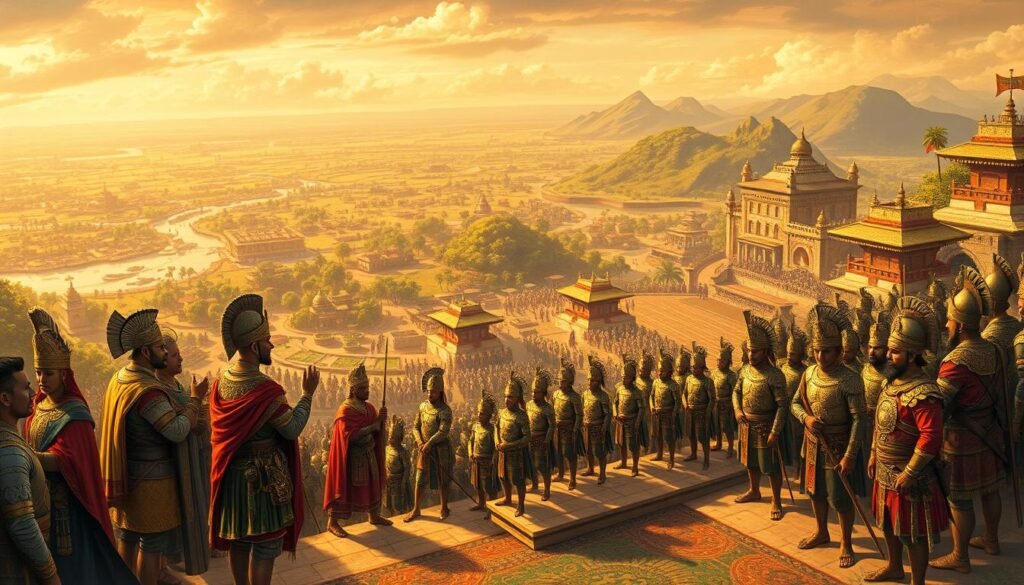
Trade Routes and Early Contacts
Trade routes were the lifeblood of early Philippine statecraft. Maritime pathways connected the archipelago to China, India, and Southeast Asia. These routes facilitated not only economic exchange but also cultural and political interactions.
Early contacts with neighboring nations introduced new ideas and practices. For example, the exchange of goods often included the sharing of knowledge and technology. This helped shape the Philippines’ approach to international relations and statecraft.
The dual role of geographical isolation and connectivity fostered both conflict and cooperation. While isolation protected communities, connectivity encouraged alliances and trade. This dynamic continues to influence the nation’s foreign policy today.
Understanding this historical context provides valuable insights into the evolution of the Philippines as a nation. It highlights how geography and culture continue to shape its approach to statecraft and international relations.
Diplomacy in Pre-Colonial Philippines: Strategies and Alliances
Early Philippine leaders mastered the art of negotiation to secure peace. They built alliances and treaties that shaped the nation’s political landscape. These strategies were rooted in cultural practices and regional interactions.
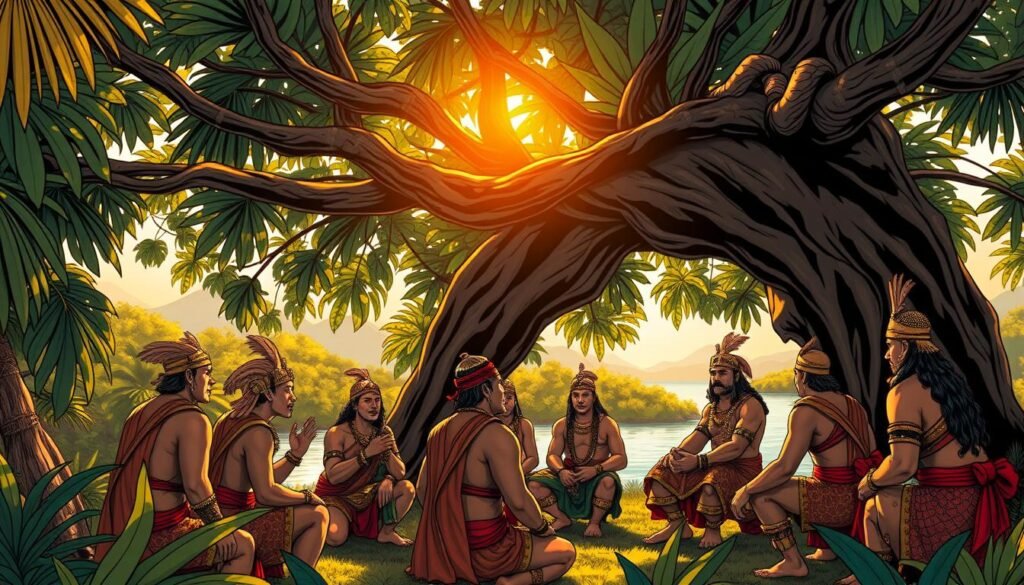
Formation of Alliances and Treaties
Alliances among early Philippine polities were strategic. Leaders formed agreements to protect their territories and ensure mutual benefits. Treaties often included trade terms and military support.
For example, alliances between coastal and inland communities strengthened economic ties. These agreements also prevented conflicts over resources. Such practices mirrored global diplomatic strategies seen in Asia and Europe.
“The exchange of envoys and gifts was a cornerstone of early Philippine diplomacy.”
Tactics for Peaceful Negotiation and Conflict Avoidance
Leaders employed various tactics to maintain peace. Gift-giving and ceremonial exchanges were common. These gestures symbolized respect and goodwill.
Negotiation was key to resolving disputes. Leaders often met in neutral territories to discuss terms. This approach ensured fairness and reduced tensions.
| Tactic | Purpose |
|---|---|
| Gift Exchanges | Build trust and goodwill |
| Neutral Meeting Places | Ensure fair negotiations |
| Ceremonial Rituals | Symbolize mutual respect |
These strategies not only prevented war but also fostered long-term relationships. The Philippines’ early diplomatic practices continue to influence its approach to international relations today.
Key Elements of Pre-Colonial Diplomatic Practice
The role of envoys in pre-colonial Philippines was pivotal in shaping early state relations. These messengers were trusted individuals tasked with delivering critical messages and negotiating terms between leaders. Their work ensured smooth interactions and helped maintain peace.
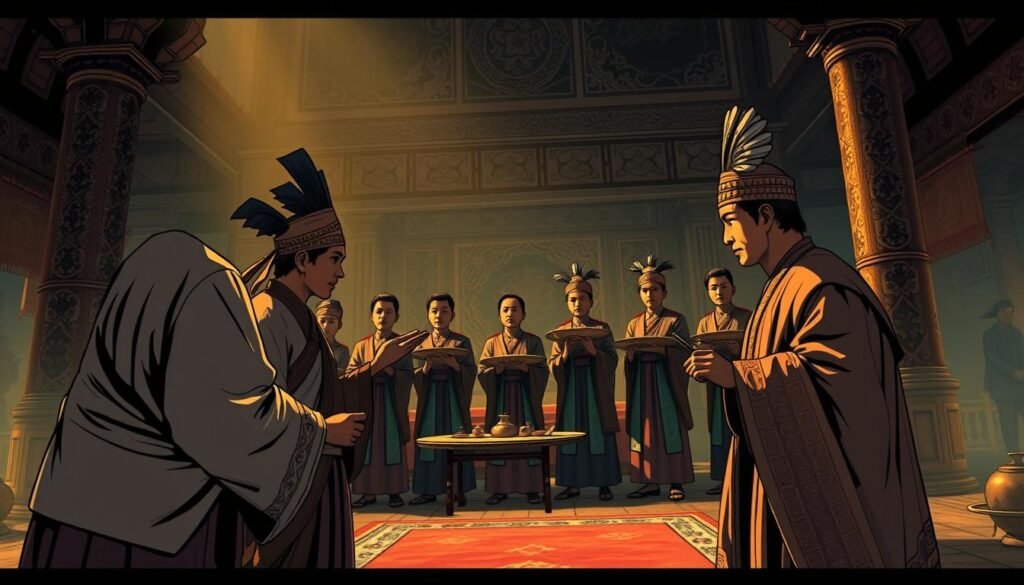
Role of Envoys and Messengers
Envoys were the backbone of diplomatic exchanges. They carried messages, gifts, and agreements between communities. Their role required trust, as they often handled sensitive information. This practice ensured that leaders could communicate without direct confrontation.
In many cases, envoys were chosen for their knowledge of local customs and languages. This helped bridge cultural gaps and fostered mutual understanding. Their work laid the foundation for formal diplomatic missions seen in later centuries.
Diplomatic Etiquette and Protocols
Formal protocols were essential in pre-colonial diplomacy. Leaders followed strict rules to show respect and avoid misunderstandings. For example, credential presentation was a ceremonial act that symbolized trust and authority.
Cultural norms heavily influenced these practices. Gift-giving, ceremonial rituals, and neutral meeting places were common. These gestures ensured that negotiations were fair and respectful.
- Gift exchanges built trust and goodwill.
- Neutral meeting places ensured fair negotiations.
- Ceremonial rituals symbolized mutual respect.
These practices highlight the sophistication of pre-colonial diplomatic interactions. They not only prevented conflict but also strengthened long-term relationships. Understanding these traditions provides valuable insights into the evolution of diplomatic practices in the Philippines.
Cultural and Political Foundations Shaping Alliances
The cultural and political foundations of the Philippines played a crucial role in shaping early alliances. Indigenous traditions and political ethos were deeply intertwined, creating a unique approach to statecraft. These foundations influenced how communities interacted and formed agreements with neighboring regions.
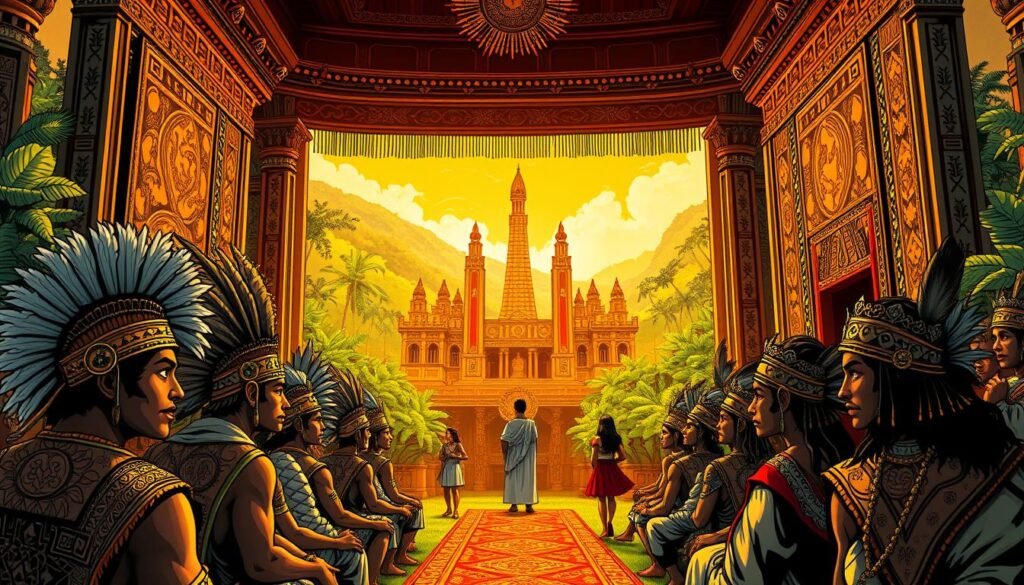
Interstate Relations and Local Traditions
Local traditions were central to interstate relations in pre-colonial Philippines. Communities relied on customary practices to build trust and foster collaboration. For example, gift-giving and ceremonial exchanges symbolized respect and goodwill, paving the way for lasting alliances.
Cultural identity also played a significant role in political objectives. Leaders often integrated local customs into broader strategies to strengthen their legitimacy. This approach ensured that alliances were not only politically beneficial but also culturally meaningful.
Trade and social exchange were vital in fostering collaborative relationships. Maritime routes connected the Philippines to other nations, facilitating the exchange of goods, ideas, and technologies. These interactions helped shape the region’s political and economic landscape.
Customary Practices in Alliance Building
Customary practices provided structure to alliance building and conflict resolution. Neutral meeting places and ceremonial rituals ensured fair negotiations. These practices minimized misunderstandings and promoted peaceful coexistence.
| Practice | Purpose |
|---|---|
| Gift Exchanges | Build trust and goodwill |
| Neutral Meeting Places | Ensure fair negotiations |
| Ceremonial Rituals | Symbolize mutual respect |
These practices were not unique to the Philippines. Similar approaches were observed in other ancient societies, highlighting the universality of cultural foundations in diplomacy. For instance, the exchange of cultural elements has long been a tool for fostering mutual understanding.
The integration of local traditions with broader political strategies was key to the Philippines’ early success. Leaders understood the importance of cultural legitimacy in securing alliances. This approach continues to influence the nation’s foreign policy today.
By leveraging its cultural heritage, the Philippines has enhanced its international relations. Initiatives like Philippine cultural diplomacy showcase the country’s unique identity and foster global cooperation.
The lasting impact of these cultural and political foundations is evident in the region’s history. They not only shaped early alliances but also laid the groundwork for modern statecraft. Understanding these traditions provides valuable insights into the evolution of the Philippines as a nation.
Influential Figures and Their Diplomatic Legacies
Historical figures in the Philippines shaped alliances through innovative strategies and cultural understanding. Their contributions laid the foundation for the nation’s diplomatic traditions. These leaders not only secured peace but also fostered relationships that transcended borders.
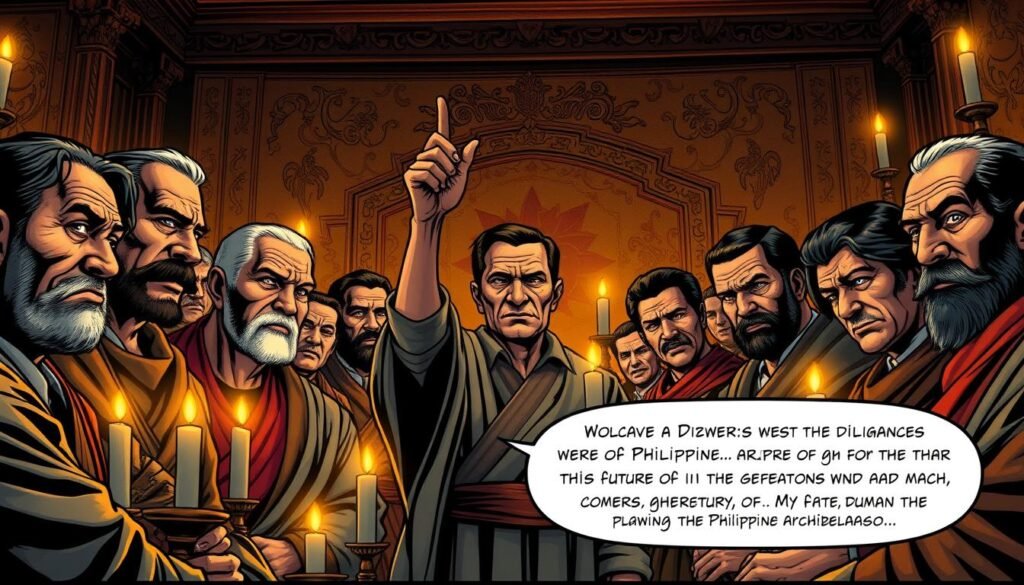
Notable Leaders and Their Impact
One of the most influential leaders was Datu Lapu-Lapu, known for his resistance against foreign domination. His leadership exemplified the importance of unity and strategic alliances. Similarly, Rajah Humabon’s negotiations with Ferdinand Magellan showcased early diplomatic skills.
These leaders were not isolated in their approaches. Their methods mirrored those of global figures like Benjamin Franklin, who emphasized mutual respect and collaboration. Such parallels highlight the universality of effective diplomacy.
Traditional Practices in Nation Building
Traditional practices played a significant role in nation-building. Leaders often relied on cultural rituals to establish trust. For example, the sandugo or blood compact symbolized unbreakable alliances. This practice was a cornerstone of early diplomatic efforts.
“The exchange of gifts and ceremonial rituals was not just symbolic but a strategic tool for building lasting relationships.”
These methods were not limited to the Philippines. Similar practices were observed in other regions, such as the Soviet Union’s emphasis on cultural exchanges. This cross-cultural influence enriched the Philippines’ diplomatic traditions.
- Datu Lapu-Lapu’s resistance inspired unity among communities.
- Rajah Humabon’s negotiations demonstrated early diplomatic acumen.
- The sandugo ritual symbolized unbreakable alliances.
The legacies of these leaders continue to influence modern diplomatic practices. Their innovative strategies and cultural understanding remain relevant in today’s globalized world.
Lessons from Pre-Colonial Diplomacy for Modern Philippine Governance
The Philippines’ pre-colonial strategies offer timeless lessons for modern governance. Ancient practices, rooted in cultural understanding and negotiation, provide a blueprint for addressing contemporary challenges. By revisiting these methods, today’s leaders can build resilient governance structures.

Adapting Ancient Strategies to Contemporary Challenges
Pre-colonial leaders excelled in building alliances and resolving conflicts through nonviolent means. These tactics, such as gift exchanges and neutral meeting places, remain relevant today. For example, modern peace initiatives often mirror these traditional methods to foster trust and cooperation.
Cultural cohesion played a significant role in early statecraft. Leaders integrated local customs into broader strategies, ensuring alliances were both politically and culturally meaningful. This approach can inspire modern leaders to leverage cultural heritage in foreign policy and governance.
Historical practices also highlight the importance of learning from the past. The sandugo ritual, symbolizing unbreakable alliances, demonstrates the power of symbolic gestures in building relationships. Such traditions can inform contemporary efforts to strengthen international ties.
| Ancient Practice | Modern Application |
|---|---|
| Gift Exchanges | Building trust in international summits |
| Neutral Meeting Places | Facilitating fair negotiations in conflicts |
| Ceremonial Rituals | Symbolizing mutual respect in diplomacy |
Modern Philippine governance can benefit from these lessons. For instance, the pre-colonial governance structures emphasize the importance of community involvement in decision-making. This approach can enhance transparency and accountability in today’s policies.
Another example is the integration of cultural diplomacy into foreign policy. As highlighted in the evolution of bilateral cultural diplomacy, cultural cooperation remains a powerful tool for enhancing international relations.
By adapting these ancient strategies, the Philippines can address modern challenges more effectively. Whether in resolving conflicts or fostering global partnerships, the wisdom of pre-colonial leaders continues to inspire progress.
Conclusion
The rich tapestry of pre-colonial Philippine alliances offers valuable lessons for today’s governance. From early trade agreements to ceremonial rituals, these practices laid the foundation for the nation’s approach to international relations. The evolution of these strategies highlights the enduring relevance of cultural understanding and negotiation in shaping alliances.
Historical practices, such as gift exchanges and neutral meeting places, continue to inspire modern governance. These methods fostered trust and cooperation, proving effective in resolving conflicts and building long-term relationships. By integrating these traditions into contemporary policies, the Philippines can address modern challenges with a blend of tradition and innovation.
Understanding this history is crucial for appreciating the country’s diplomatic heritage. It underscores the importance of cultural legitimacy in fostering global partnerships. For further insights into the role of diplomacy in international relations, explore this comprehensive guide.
As the Philippines navigates today’s complex global landscape, the wisdom of its ancestors remains a guiding light. By learning from the past, the nation can build a future rooted in resilience, collaboration, and mutual respect.
FAQ
What were the main geographical and cultural influences on pre-colonial Philippine statecraft?
The Philippines’ strategic location in Southeast Asia and its diverse cultural heritage shaped its early diplomatic practices. Proximity to major trade routes and interactions with neighboring regions like China and the Malay Archipelago played a significant role.
How did trade routes impact early diplomatic contacts in the Philippines?
Trade routes facilitated exchanges of goods, ideas, and cultural practices. These interactions laid the groundwork for alliances and diplomatic relations with other nations and regions.
What tactics were used for peaceful negotiation and conflict avoidance in pre-colonial Philippines?
Leaders often relied on envoys, cultural exchanges, and mutual agreements to resolve disputes. Rituals and ceremonies were also used to strengthen bonds and ensure peaceful coexistence.
What role did envoys and messengers play in pre-colonial diplomatic practices?
Envoys acted as intermediaries, delivering messages and negotiating terms between communities. Their role was crucial in maintaining trust and fostering alliances.
How did local traditions influence interstate relations in the pre-colonial Philippines?
Local customs, such as kinship ties and shared cultural practices, often guided diplomatic interactions. These traditions helped build mutual respect and cooperation among different groups.
Who were some notable leaders in pre-colonial Philippine diplomacy?
Leaders like Lapu-Lapu and Rajah Humabon are remembered for their strategic alliances and resistance against foreign powers. Their legacies highlight the importance of leadership in shaping diplomatic outcomes.
How can ancient diplomatic strategies be adapted to modern Philippine governance?
Lessons from pre-colonial practices, such as fostering cultural understanding and prioritizing peaceful negotiations, can inform contemporary approaches to international relations and conflict resolution.
Source Links
- History of the Philippines | People, Spain, United States, Revolution, Map, & Facts | Britannica
- Foreign relations of the Philippines
- Explore Pacific Forum’s Insightful Indo-Pacific Analysis
- The Philippines: Economic Statecraft and Security Interests Can Save a Critical Alliance
- A Practicum – Association for Diplomatic Studies & Training
- Diplomacy as an instrument of good governance – Diplo Resource
- Diplomacy – Negotiation, Protocol, Relations | Britannica
- No title found
- Peace and palaver: international relations in pre-colonial West Africa1 | The Journal of African History | Cambridge Core
- The impact of cultural diversity on multilateral diplomacy and relations – Diplo Resource
- Philippine Cultural Diplomacy: Unraveling its Full Potential
- Cultural diplomacy
- Her Diplomacy – The National Museum of American Diplomacy
- Blinken’s legacy of diplomacy
- Rethinking colonialism through early modern global diplomacy: A tale of Pampangan mobility | Journal of Global History | Cambridge Core
- No title found
- Conclusion: National Diplomacy and Global Governance

